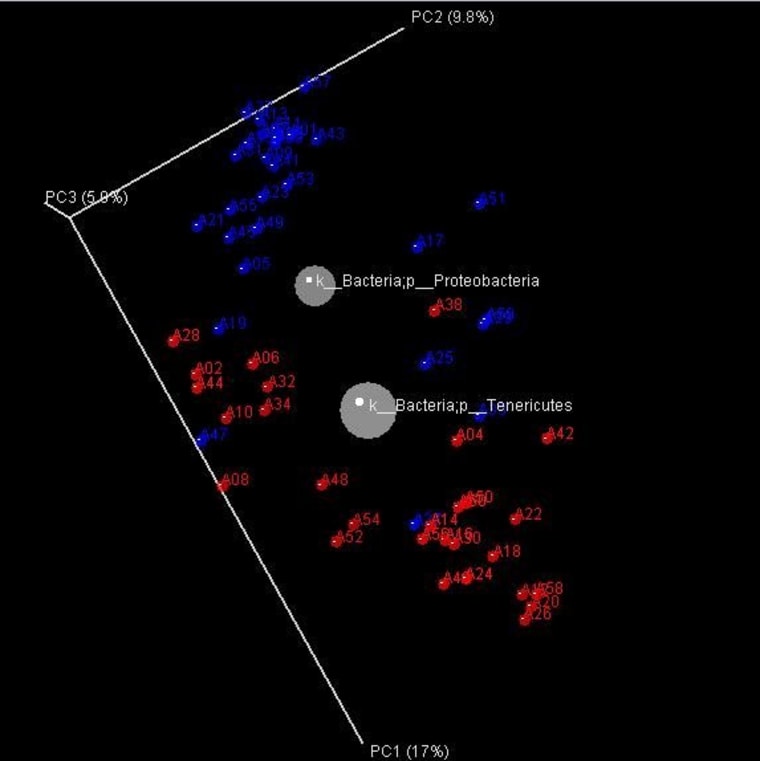Your cell phone and your shoes have whole communities of microbes living on them, as distinctive as the germs on your fingers and in your mouth.
Among the bacteria that typically live in your pocket are the relatives of nasty bugs that can cause pneumonia, meningitis and gonorrhea. In contrast, the soles of your shoes could harbor bacteria related to E. coli, salmonella and the microscopic critters that cause pink eye.
Eww, right? Maybe a more appropriate reaction would be "Wow!" At least that's the way I see it, as a participant in what could be the world's first comparative study of smartphones and shoes.
"We've never actually done this stunt before," said Jack Gilbert, a microbial ecologist at Argonne National Laboratory and the University of Chicago. He and his colleagues had yours truly and 30 other journalists swab their phones and their shoes to collect the microbial samples last weekend in Vancouver, Canada, during a news briefing at the annual meeting of the American Association for the Advancement of Science. The results of the DNA tests, conducted under the auspices of the Earth Microbiome Project, were distributed today.
Jonathan Eisen, a microbiologist at the University of California at Davis, said today's gene-sequencing technologies makes it possible to process genetic samples for mere hundreds of dollars, as opposed to millions of dollars, in a fraction of the time it used to take. "Five years ago, this would have taken our lab six months or more," he said.
That technological quantum leap is opening up new scientific frontiers. "For the first time, we're able to do surveys of places quickly and cheaply," Eisen said. "It's like we're kids in a candy store."
Last year, researchers turned up the "eww" factor by analyzing the microbial communities in public restrooms, which include germs linked to staph and diarrhea. Some of the researchers involved in the Earth Microbiome Project charted the microbial signatures of toilet seats, restroom floors and sink surfaces, and found that the flush handles and seats were "relatively enriched" with bacteria from our bowels.

Compared to those findings, the results from the phone-vs.-shoe study are positively tame. "We found nothing that was pathogenic ... which means all of you are healthy. That's a good thing," Gilbert said.
There was a clear difference between the bacterial signatures of our shoes and our phones, although a couple of the samples look as if they were switched — suggesting that journalists don't always follow directions.
The researchers couldn't take samples from our bodies, because that would have run counter to the privacy guidelines for their experiments. But the fact that the cellphone samples were so similar suggests that we nurture those microbial communities with the germs from our hands. And we're not talking just about phones.
"One of the reporters in the room didn't have a phone on him, and said, 'Could you sample my wallet instead?' The sample from his wallet looks exactly like the smartphones," Gilbert said.
As for those nasty-sounding bacterial types, Gilbert said we shouldn't worry too much. These bacteria are almost certainly benign cousins to the bad sort of bugs. "The hypothesis is that the good bacteria are out-competing the bad bacteria," Gilbert said. "If they weren't there, the pathogens may be able to take root."
Our shoes reflected a wider diversity of microbes than the cell phones did — which makes sense when you consider how much we had to walk through to get to the news briefing in Vancouver. "There was one pair of shoes which was a significant outlier to the rest of the data," Gilbert observed. "We don't know why. It could have been that the person who owned those shoes may have stepped in some mud or something. ... If the person's been walking in a different environment from everybody else, we could potentially trace where someone is walking."
Which raises the question: Could your microbes serve as diagnostic tool, or even a detective tool? Researchers have talked about being able to figure out what ails you by analyzing your personal microbiome, but they're not there yet. Eventually, it may even be possible to read your whole history by checking exactly which bacteria you've picked up from which places.
"There's enough to suggest that this might be a tool, but the robustness of that tool would have to be seriously investigated," Gilbert said.
That's what the Earth Microbiome Project is all about.
"Anybody out there who is interested in microbes in the water, microbes in the air, microbes on skin, microbes on pets ... anybody can participate in the Earth Microbiome Project," Eisen said. "I can imagine scaling up to millions and millions of samples. If a citizen science project or a high-school class has an interesting quest, they can do this now."
Is that something that makes you go eww, wow ... or uh-oh? Please feel free to make your opinion known by registering a vote above, or leaving a comment below.
More about microbes:
- Scientists map the world's microbes
- Bacteria's slimy biofilm could help humans
- Scientists study belly-button bacteria
- Soap isn't always as clean as it seems
- Bacteria prefer prime real estate
For more about the phone-vs.-shoe experiment, check out the Home Microbiome Study's website and Facebook page.
Alan Boyle is msnbc.com's science editor. Connect with the Cosmic Log community by "liking" the log's Facebook page, following @b0yle on Twitter or following the Cosmic Log Google+ page. You can also check out "The Case for Pluto," my book about the controversial dwarf planet and the search for new worlds.
